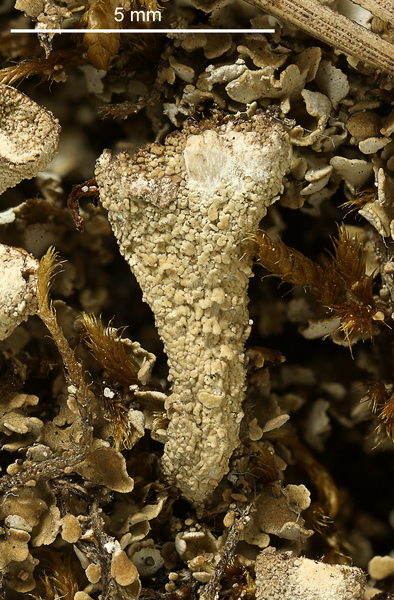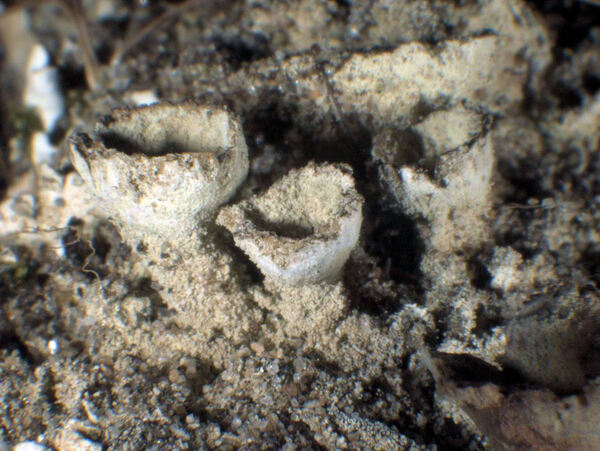Cladonia cryptochlorophaea Asahina
J. Jap. Bot., 16: 711, 1940.
Synonyms:
Distribution: N - Frl (Burgaz & al. 2020), Ven (Ravera & al. 2022b), Lig (Gheza & al. 2020). C - Tosc, Laz, Sar (Burgaz & al. 2020). S - Si (Burgaz & al. 2020).
Description: Primary thallus squamulose, persistent, the squamules middle-sized (1-3 mm), thin, ascending, greenish grey above, white beneath. Podetia goblet-shaped, hollow inside, brownish green to dark greenish grey, usually not melanotic at base, 0.5-1.5(-2) cm tall, 0.5-1 mm thick, with 4-6 mm wide cups gradually tapering to a short stalk, regular or proliferating marginally, with granular, 30-80 μm thick soredia, corticated granules, phyllidia and microsquamules in upper part and in the cups. Apothecia infrequent, brown, convex, developing at the margins of cups. Asci 8-spored, clavate, thickened at apex, with a K/I+ blue tholus and a K/I+ strongly blue outer gelatinous sheath, Cladonia-type. Ascospores 1-celled, hyaline, ellipsoid. Pycnidia dark, semi-immersed along the margins of cups, with a colourless jelly. Conidia hyaline, curved. Photobiont chlorococcoid. Spot tests: K+ yellow turning wine-red, C+ fleeting wine-red or C+ yellow-orange, KC+ wine-red, P+ red, UV+ pale yellow. Chemistry: cryptochlorophaeic and paludosic acids, substances of the fumarprotocetraric acid complex, plus inconstant traces of 4’-O-methylcrypthochlorophaeic and subpaludosic acids.Note: a mainly cool-temperate, perhaps holarctic lichen found on soil rich in humus, on peat, etc., probably with a western distribution in Europe. Perhaps better treated as a chemical strain of C. grayi.
Growth form: Fruticose
Substrata: lignum, soil, terricolous mosses, and plant debris
Photobiont: green algae other than Trentepohlia
Reproductive strategy: mainly asexual, by soredia, or soredia-like structures (e.g. blastidia)
Most common in areas with a humid-warm climate (e.g. most of Tyrrenian Italy)
Commonnes-rarity: (info)
Alpine belt: absent
Subalpine belt: extremely rare
Oromediterranean belt: absent
Montane belt: very rare
Submediterranean belt: extremely rare
Padanian area: absent
Humid submediterranean belt: extremely rare
Humid mediterranean belt: extremely rare
Dry mediterranean belt: absent
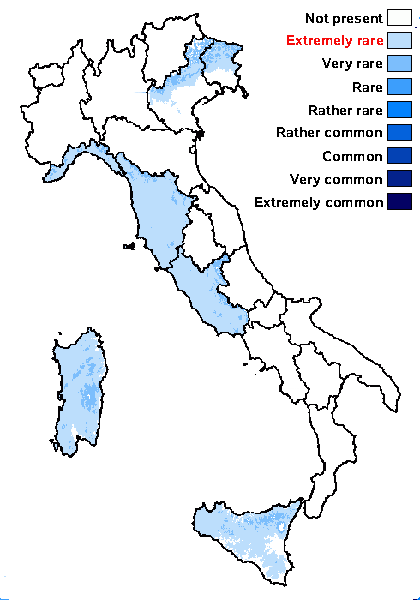
Predictive model
Herbarium samples
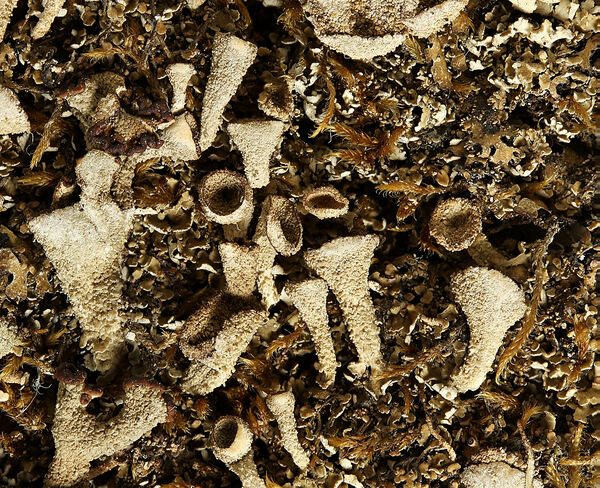

Felix Schumm CC BY-SA 4.0
Germany, Baden-Württemberg, Schwarzwald, Mitteltal, auf einem Laubbaum über Moosen.
Leg. Eisele 17.03.1947, det. J. Poelt als Cladonia chlorophaea
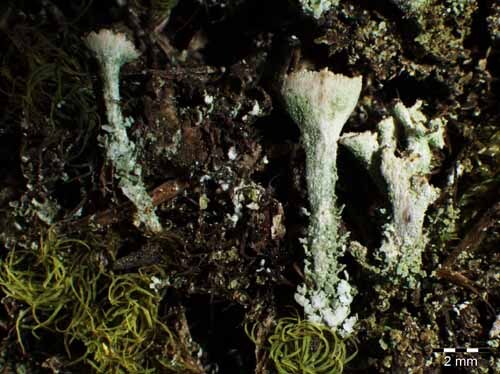
Harrie Sipman – Source http://www.bgbm.fu-berlin.de/sipman/Zschackia/AegeanLichens/CaloplacaAC.htm - As Caloplaca oasis
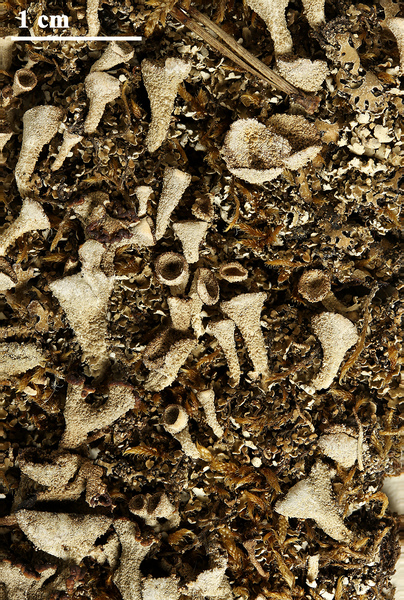

Felix Schumm – CC BY-SA 4.0
[340], Germany, Baden-Württemberg, Schwarzwald, Mitteltal, auf einem Laubbaum über Moosen. Leg. Eisele 17.03.1947, det. J. Poelt als Cladonia chlorophaea
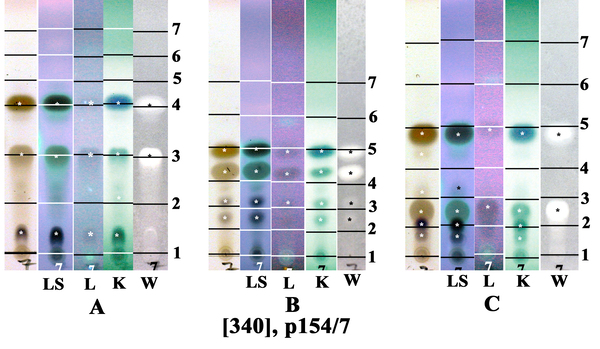

Felix Schumm – CC BY-SA 4.0
: [340], Germany, Baden-Württemberg, Schwarzwald, Mitteltal, auf einem Laubbaum über Moosen. Leg. Eisele 17.03.1947, det. J. Poelt als Cladonia chlorophaea,
1: fumarprotocetraric acid, 2: protocetraric acid, 3: cryptochlorophaeic acid, 4: paludosic acid, 5: unknown, conf. J.A. Elix
Growth form: Fruticose
Substrata: lignum, soil, terricolous mosses, and plant debris
Photobiont: green algae other than Trentepohlia
Reproductive strategy: mainly asexual, by soredia, or soredia-like structures (e.g. blastidia)
Most common in areas with a humid-warm climate (e.g. most of Tyrrenian Italy)
Commonnes-rarity: (info)
Alpine belt: absent
Subalpine belt: extremely rare
Oromediterranean belt: absent
Montane belt: very rare
Submediterranean belt: extremely rare
Padanian area: absent
Humid submediterranean belt: extremely rare
Humid mediterranean belt: extremely rare
Dry mediterranean belt: absent

Predictive model
| Herbarium samples |


Felix Schumm CC BY-SA 4.0
Germany, Baden-Württemberg, Schwarzwald, Mitteltal, auf einem Laubbaum über Moosen.
Leg. Eisele 17.03.1947, det. J. Poelt als Cladonia chlorophaea

Harrie Sipman – Source http://www.bgbm.fu-berlin.de/sipman/Zschackia/AegeanLichens/CaloplacaAC.htm - As Caloplaca oasis


Felix Schumm – CC BY-SA 4.0
[340], Germany, Baden-Württemberg, Schwarzwald, Mitteltal, auf einem Laubbaum über Moosen. Leg. Eisele 17.03.1947, det. J. Poelt als Cladonia chlorophaea


 Index Fungorum
Index Fungorum
 GBIF
GBIF
